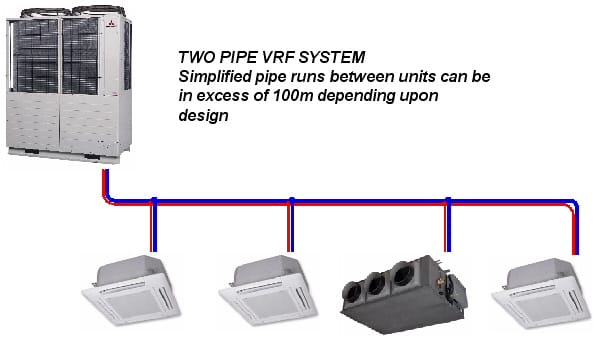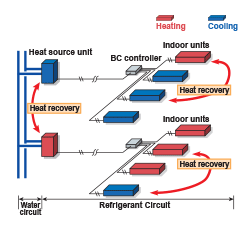VRF Technology – Part 2
- Details
VRF Technology – what you need to know
Part 2 – Indoor or outdoor VRF Condensers
Variable refrigerant flow (VRF), also known as variable refrigerant volume (VRV), use refrigerant as the cooling and heating medium. This refrigerant is conditioned by a condensing unit, and is circulated within the building to multiple indoor units. For the basics on a VRF system, please see Part 1 of this series.
VRF System types
The condensing unit can be either an air source (outdoor) or water source (indoor) condenser. An air source condenser is used when it can be located outdoors within the limiting distance. The diagram below would be a simple example of each zone.

In a water source condenser, water is used as the heat transfer fluid. This means the condenser can be located inside in a small mechanical room. Circulating water is then used to transfer heat as required. The diagram below shows this process.

Water Source condenser VRF system
Circulated water is then piped to a central mechanical room where a combination of a boiler, chiller or fluid cooler is used.
Initial costs verses operating costs
HVAC systems are obviously one of the key factors of building energy consumption. Studies investigated the system performance and economic value of variable refrigerant flow (VRF) systems relative to conventional HVAC systems.
One comparative analysis covered six building types - medium office, standalone retail, primary school, hotel, hospital, and apartment - in a eleven climate zones. The major findings are that the VRF system has an average of 39% percent HVAC energy consumption savings.
A VRF system complete with a Dedicated Outdoor Air System (DOAS) provide a very high efficient HVAC system. If you are unfamiliar with DOAS, we have a past article on these systems. (dedicated-outdoor-air-systems).
For more information on this topic and others, please contact our office:
The TLJ Team